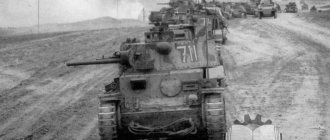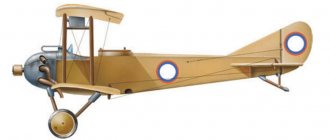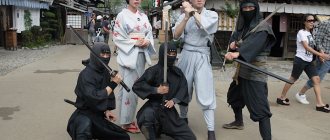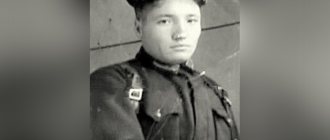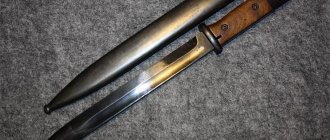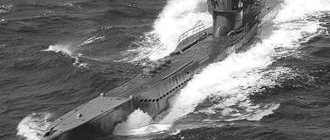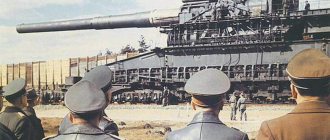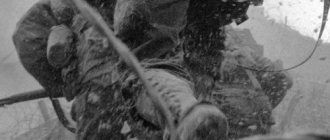The development of airspace is a relatively new stage in the development of industry, which began at the end of the 19th century. The term “aviation” itself is translated as “bird”. For the first time, humanity learned the strength and power of iron hawks with the advent of one of the most destructive and cruel events in history - World War I. The aircraft of these times did not have good technical parameters, but gave rise to the emergence of high-quality and useful devices, both for air battles and for passenger flights.
The appearance of the first military aircraft
Airplanes of World War I began to appear during the beginnings of the conflict. Initially, these were bulky and clumsy “flying tanks” capable of transporting personnel. They were not equipped with assault machine guns or bomb compartments. The main firepower of World War I aircraft was provided by personnel weapons.
As military craft developed, by 1915, fighter aircraft began to appear. They reached speeds of up to 150 km/h and could cause serious damage to infantry and tanks. They used weapons of varying effectiveness, including machine guns, steel weights and grenades.
Bombers exemplified the military superiority of German aircraft during World War I. At that time, these were the most destructive, large-sized and impenetrable vehicles. With the advent of these means, sirens began to appear in many European cities, notifying the local population of the approach of bombing attacks.
Britannia
The best British military airliners were the so-called De Havillands. Initially, such 4-series airliners took part in hostilities. But gradually their production improved. This model was developed up to the 9th series
During the development process, experts paid attention to such an aspect as the interaction of crew members during the flight. If the first models between the pilot's cabin and the observer had a distance of about 1 m, then in the latest models this distance was significantly reduced, since there was no on-board communication at that time
These planes had the most powerful engines at that time. They also featured a higher combat load compared to other single-engine aircraft of the time. The Soviet R-1 aircraft, which was used for reconnaissance, was a copy of De Havilland's latest model.
Airplanes of Germany
The military forces of the Central Powers at the time of the First World War were far ahead of many European states. Despite the obvious weakness of the Allies, Germany was the second power in the number of aircraft in the world. It had 240 Taube units and was a serious competitor to the Entente. The First World War gave impetus to the development of the aircraft manufacturing industry and secured the sad glory of German bombers, which destroyed everything in their path.
Thanks to the rapid development, the troops of the Central States were able to strengthen their dominant position in the air almost until the very end of World War I. German aircraft were the first to be used to bomb enemy strategic targets. The most famous aircraft were the light triplanes Foker and Taub. They were lightweight structures capable of conducting fast and effective battles.
German airships as part of the Air Force
In addition to bombing from the usual aircraft today, Germany also used airships in its bombing. During the 4 years of the war, the Germans built more than 100 Zeppelins and Schutte-Lants. Unlike civilian airships, military vehicles were provided with powerful protection against all types of known weapons.
Such aviation was ideal for ensuring the protection of naval approaches to the borders of occupied territories and bombing strategic targets located on the line of contact.
Uniforms and insignia
Aviation units wore uniforms introduced on January 3, 1914. With the exception of the cut of the uniform (single-breasted, similar to the vice-uniform of the Guards heavy cavalry), it was similar to the uniform of the engineering troops: “scientific” red piping on the collars, buttons, belt buckles and other white metal fittings, cap bands, overcoat buttonholes and collars (only for officers) are made of black cloth (velvet) with red piping; Crossed axes with long handles were added to the usual emblem on buttons and buckles (double-headed eagle).
Everyday shoulder straps were made of red cloth; for officers - with silver braid, a special badge in the form of a propeller with wings, golden stars for ranks and encryption, and for lower ranks - with the same images, but applied in yellow paint, with silver or white stripes for ranks. Encryptions of letters and numbers indicated the abbreviated name of the part.
The marching shoulder straps were of a protective (dull green) color; for the lower ranks, they had images painted in brown paint.
Officers who had the rank of “military pilot” wore on their shoulder straps, instead of a propeller with wings, a special sign indicating their qualifications - a blackened silver double-headed eagle with a medallion with the monogram of Nicholas II on the chest and a sword, a propeller and a bomb in its paws.
Many officers of aviation units (pilots and observers) formally continued to be registered in their regiments, battalions or batteries, and therefore wore their usual regimental uniform, but with the addition of the sign described above (to whom it belonged).
The service uniform included a naval-style blue jacket (lower ranks had a blue shirt), but it was also allowed to wear a protective, all-army one. Another unusual, “naval” detail of the pilot officer’s costume was the naval dagger.
For flights and service at airfields, a special folding cap was used - a “pilot”, black, with red piping, silver braid and a cockade; Subsequently, this headdress, having undergone minor changes, will become the most common in the domestic armed forces. In addition, insulated leather jackets, trousers and a special flight helmet were used for flights.
German Allied aircraft
As you know, one of the main reasons for the defeat of the troops of the German Empire was the low preparedness of the Allied troops. Austria-Hungary and the Ottoman Empire were extremely poorly qualified in the field of aviation. Excessive conservatism cost them defeat in the war.
If we talk about specific numbers, then Austria-Hungary had only 30 aircraft in service, including the O and the Foker. Only towards the end of the war did the Allies begin mass production of fighters.
The Ottoman Empire did not have air-military forces at all. At the outbreak of World War I, the aircraft were ordinary airplanes for passenger cargo transportation. Germany assisted in ensuring the air superiority of the Ottoman Empire by supplying the most modern models such as the Palatinate, Rampler and Taub. These were the most popular and popular models of the early 20th century, which had low resistance to enemy attacks.
Aircraft manufacturing plants of Russia
| Aircraft factory name | Location | Start of airplane production | Number of workers in 1914/1917 | Number of machines (1917) | Average monthly production of aircraft in 1916-1917. |
| PRTV "S.S. Shchetinin and Co" ("Gamayun") | Petrograd | 1910 | 400/1530 | 43 | 24 |
| RBVZ ("Avia-Balt") | Riga, Petrograd | 1910 | 270/475 | 36 | 3 |
| "Dux" | Moscow | 1912 | 550/2500 | 195 | 39 |
| Aviation plant V.V. Slyusarenko | Riga, Petrograd | 1913 | 30/300 | 16 | 5 |
| Aeronautics JSC “V.A. Lebedev" | Petrograd | 1914 | 300/1435 | 37 | 19 |
| Factory F.F. Tereshchenko | Chervonnoe | 1914 | 25/ — | — | — |
| Airplane Factory A.A. Anatra | Odessa | 1914 | 100/2200 | 131 | 17 |
| Moscow Aviation Plant F. Mosca | Moscow | 1915 | — /313 | 48 | 2 |
| First Crimean Airplane Plant V.F. Adamenko | Karasubazar | 1916 | — /175 | — | 1 |
| Plant of airplanes and aircraft engines A.A. Anatra | Simferopol | 1917 | — /700 | 60 | 5 |
| JSC "Widow Mathias and Sons" | Berdyansk | 1919 | — /500 | 50 | — |
| Taganrog plant V.A. Lebedeva | Taganrog | 1923 | — /200 | — | — |
- Author: Vladimir
Rate this article:
- 5
- 4
- 3
- 2
- 1
(0 votes, average: 0 out of 5)
Share with your friends!
similar entries from this section
Rifles of the First World War Balkan Wars - prehistory to the First World War Top 10 exploits of Russian soldiers during the First World War
Russian Imperial Air Force
Despite Russia's strong lag behind the rest of the world, in terms of military power it had practically no equal, except for the French and German troops. The same applies to the air force. The names of the World War I aircraft that took part in clashes on the part of the Russian Empire remained well known for many years.
At the time of 1914, Russia had more than 260 aircraft in service, which exceeded all countries participating in the conflict. And this despite the fact that the air fleet had not yet been fully formed. The main striking force of the empire was the first multi-engine Ilya Muromets - the most advanced and powerful bombers.
In addition to the latest developments, Russia also used older models, which were significantly inferior not only to new products, but also to the developments of German engineers. Today such planes are called “Corn Ruckers”. They were made from the most ordinary wooden plywood, and therefore were extremely vulnerable against any type of weapon, be it machine guns or pistols. Basically, such means were used during night flights and reconnaissance operations.
The Russian Empire became the first country in the world to use aircraft carriers in its arsenal. In total, there were 5 ships in service capable of carrying aircraft.
Tactics of air combat in the First World War
Ramming Pyotr Nesterov during an air battle.
In the initial period of the war, when two aircraft collided, the battle was fought with personal weapons or with the help of a ram. The ram was first used on September 8, 1914 by the Russian ace Nesterov. As a result, both planes fell to the ground. On March 18, 1915, another Russian pilot used a ram for the first time without crashing his own plane and successfully returned to base. This tactic was used due to the lack of machine gun weapons and their low effectiveness. The ram required exceptional precision and composure from the pilot, so the rams of Nesterov and Kazakov turned out to be the only ones in the history of the war.
In the battles of the late period of the war, aviators tried to bypass the enemy plane from the side, and, going into the enemy’s tail, shoot him with a machine gun. This tactic was also used in group battles, with the pilot who showed the initiative winning; causing the enemy to fly away. The style of air combat with active maneuvering and close-range shooting was called “dogfight” (“dog fight”) and dominated the idea of air warfare until the 1930s.
A special element of the air combat of the First World War were attacks on airships. Airships (especially of rigid construction) had quite numerous defensive weapons in the form of turret-mounted machine guns, at the beginning of the war they were practically not inferior to airplanes in speed, and usually had a significantly superior rate of climb. Before the advent of incendiary bullets, conventional machine guns had very little effect on the airship's shell, and the only way to shoot down an airship was to fly directly over it and drop hand grenades on the ship's keel. Several airships were shot down, but in general, in air battles of 1914-1915, airships usually emerged victorious in encounters with aircraft.
The situation changed in 1915, with the advent of incendiary bullets. Incendiary bullets made it possible to ignite the hydrogen mixed with the air, flowing through the holes pierced by the bullets, and cause the destruction of the entire airship.
The tactics of Russian aviation also had their own characteristics.
Royal Flying Corps
The British Empire became one of the first countries to develop aircraft for military purposes. Photos of aircraft from World War I that fought on the side of Great Britain can be seen in many well-known publications that appeared after 1918.
Despite the high level of personnel training, British aircraft were slightly inferior to German and French aircraft. The first British fighter aircraft equipped with a high-precision machine gun was the Vickers aircraft. Its development began in 1912, and by the beginning of World War I, 60 copies had been produced. During the war, more than 3.3 thousand airplanes were also created, which made the British Air Force the most numerous troops in post-war Europe.
The scope of use of combat vehicles was very different, ranging from patrolling the vicinity of the contact line, ending with aerial bombardment and reconnaissance operations. With the help of aircraft, British intelligence officers were dropped behind enemy lines, which played an important role during the war.
Bombing tactics
At the beginning of the war, not a single country had specialized aerial bombs in service. German Zeppelins carried out their first bombing missions in 1914, using conventional artillery shells with fabric surfaces attached, and the planes dropped hand grenades on enemy positions. Later, special aerial bombs were developed. During the war, bombs weighing from 10 to 100 kg were most actively used. The heaviest aerial munitions used during the war were first a 300-kilogram German aerial bomb (dropped from Zeppelins), a 410-kilogram Russian aerial bomb (used by Ilya Muromets bombers) and a 1000-kilogram aerial bomb used in 1918 on London from German multi-engine Zeppelin-Staaken bombers
Devices for bombing at the beginning of the war were very primitive: bombs were dropped manually based on the results of visual observation. Improvements in anti-aircraft artillery and the resulting need to increase bombing altitude and speed led to the development of telescopic bomb sights and electric bomb racks.
The number of daily bombing raids by the French Air Force was as follows. A) Targets located no further than 30 km from the front: in 1915 – 18; in 1916 – 9; in 1917 (until August) - 2; from September 1917 to March 21, 1918 – 26; from March 21, 1918 until the armistice - 6. Accordingly, a total of 61 bombings. A) Targets located no further than 60 km from the front: in 1915 - August 1917. - 15; in September 1917 – November 1918 – 11. Total – 26 raids. B) On targets located at a distance of more than 100 km - only 6 raids dating back to the period before September 1917.
French aviation
It is rightfully considered the most powerful striking force of the period 1914-1918. If we talk about what kind of aircraft were in France during World War I, it is extremely difficult to underestimate them. It is on the basis of these developments that world aviation is still developing today.
The main difference from developers in other countries is that when creating projects, not only the most advanced engineers, but also the pilots themselves participated. Thanks to such cooperation, the “storm of the sky” was born - Moran Sayulnir-M, which became the best fighter presented at the beginning of the war. During its development, pilots' assessments were taken into account, the most vulnerable parts of the aircraft were strengthened, and it became possible to fire a machine gun through the propeller.
Reconnaissance aircraft deserve special attention. The Blériot 11 also became the best reconnaissance aircraft. If you look at an archival photo of World War I aircraft, you can note the exceptional innovation of French aircraft.
Italian Air Force
If we talk about the pace of aviation development, Italy has become the fastest growing power in this field. Despite varying success in terms of domination in the sky, the Italians were able to move to a fundamentally new level. If at the beginning of the war Italy did not even have its own aircraft, then a year later the best heavy bombers, Caproni K-1 and Caproni K-2, were produced. The prototypes were so successful that they were able to pass tests at sites unprepared for such actions. These were extremely strong and heavy vehicles, capable of flying up to several thousand kilometers without requiring refueling or technical repairs.


